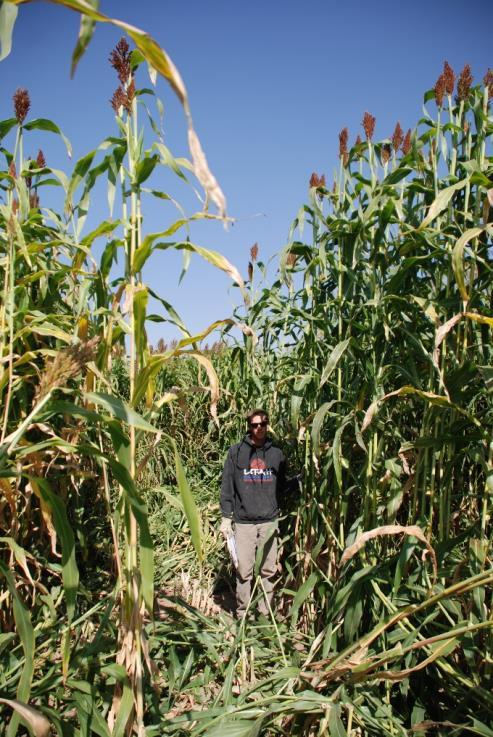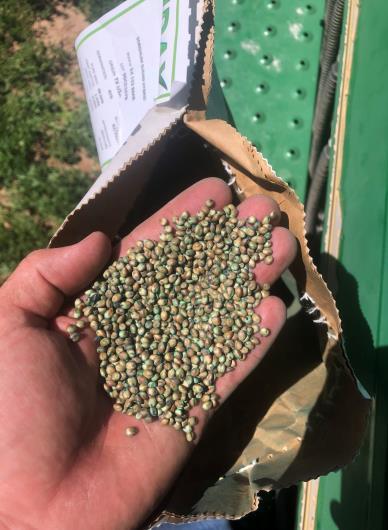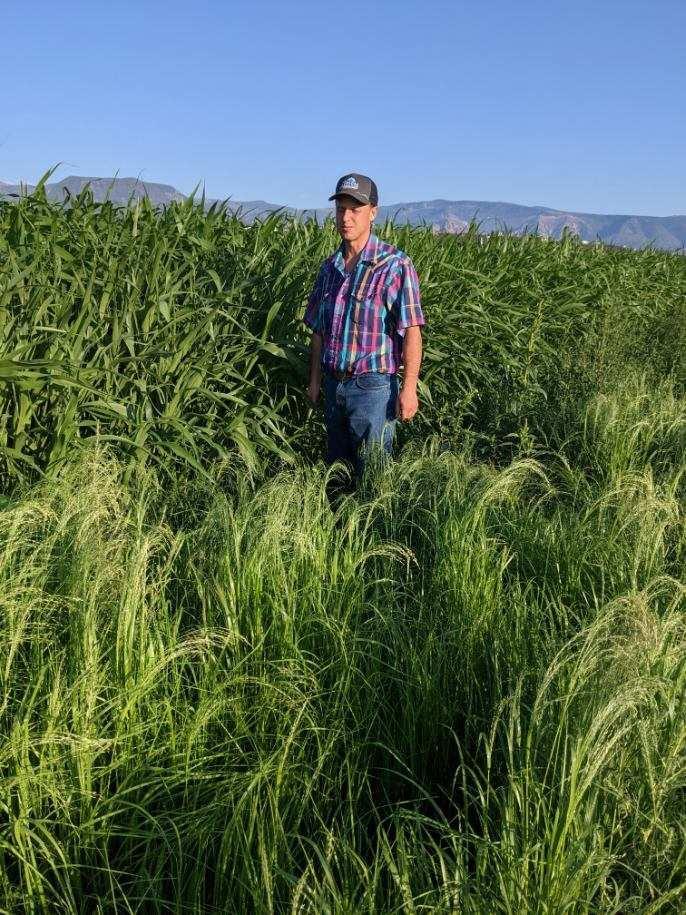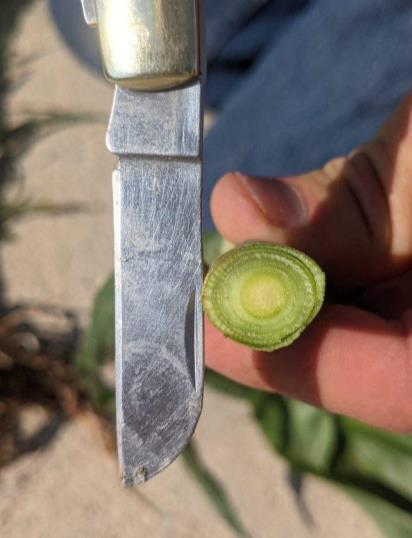Nutrient Management
Fertilizer recommendations for Sudex are similar to corn grown for silage (Harper & Roth, 1995), with the exception of a reduced nitrogen requirement. Like most grasses, nitrogen (N) is one of the most important factors for maximum yields. Most recommendations call for around 50 pounds N/acre, but, like corn, the N needs of Sudex vary by location, year, and prior field history. In Ontario, a Sudex trial showed that 111 pounds N/acre maximized yield, but the most economical N rate was between 74 95 pounds N/acre (Beyaert & Roy, 2005; Björkman & Shail, 2010). No replicated Sudex N trials have been conducted in Utah. Therefore, based on previous research in other regions, Sudex in Utah likely requires between 50 100 pounds N/acre.
When multiple cuttings will occur, splitting fertilizer applications into equal halves can improve yield and reduce the risk of forage nitrate poisoning. Ideally, fertilizer would be applied after emergence, when plants are 1 2 inches tall, and then again after the first cutting (Beyaert & Roy, 2005). If Sudex follows a well established alfalfa stand, no N will likely be needed, similar to the recommendation for corn silage following alfalfa (Creech et al., 2019). Further, the N needs should also be less when Sudex is grown as the second crop following alfalfa termination.
Nitrogen uptake is important for forage quality because it increases protein, but excessive nitrate accumulation is a concern in Sudex, especially during stress due to drought, weeds, or other factors. Nitrate levels tend to be exceptionally high in new growth for three to four days after a drought breaking rain or irrigation because roots absorb nitrates rapidly (Cassida, 2012) Accumulation can be variable throughout the plant, as evidenced by a study at Oklahoma State University that showed three times the amount of nitrates in the lower six inches than in the top portion of the plant (Strickland et al., 2017). Similarly, young plants and new regrowth following haying increase the risk for high nitrate levels.
Figure 1 Single Cutting Forage Sorghum Trial at USU Greenville Farm in Logan, Utah


Unlike prussic acid, nitrates do not dissipate during drying for hay or after killing frost and concerns are not always eliminated during ensiling (Cassida, 2012). Fortunately, in some cases, ensiling can reduce nitrate levels from moderate to safe (Bernard, 2019). The best insurance is carefully monitoring nitrate levels to ensure that Sudex forage is safe to feed or graze. A certified lab can conduct testing for nitrates in forage for around $25, which is inexpensive compared to the value of lost livestock due to nitrate poisoning.
Trials to examine the nutrient requirements of Sudex beyond nitrogen are lacking in Utah and surrounding states. Therefore, until replicated trials are completed, it is best to follow corn fertilizer guidelines for all other nutrients (phosphorus, potassium, sulfur, and micronutrients; see Cardon et al., 2008). These guidelines indicate that Sudex response to phosphorus, potassium, and sulfur fertilizer is likely when soil test phosphorus is less than 15 ppm, soil test potassium is less than 150 ppm, and soil test sulfur is less than 8 ppm.
2
Micronutrient needs should be minimal on most Utah soils but should be monitored for in season deficiencies and corrected with liquid fertilizer applications when deficiencies occur. Colorado State University research found that sorghum species, including Sudex, can be especially susceptible to zinc and iron deficiencies (Westfall & Bauder, 2011). Zinc deficiencies exhibit a broad band of white to translucent tissue near the leaf’s midrib on the mid lower portion and often cause stunted growth. Zinc deficiencies can often be corrected by applying 5 10 pounds of zinc/acre or 15 30 pounds of zinc sulfate per acre, which can be sufficient for three to four years. Iron deficiencies can occur in Utah due to the high pH of our soils. Iron deficiencies can be recognized by the appearance of yellow leaves with dark green veins and a striped appearance in corn and sorghums (Westfall & Bauder, 2011). However, there is currently no economically feasible treatment for iron deficiencies in field crops.
Variety Selection

Like all other crops, ensure that Sudex varieties are well adapted to local growing conditions. Seed dealers in Utah report that the Sudex varieties used most frequently include ‘Honeysuckle’ and ‘Super Sugar DM,’ which are typically grown for high tonnage and with less concern for high digestibility Other common varieties, such as FS301BMR, FS6BMR, and SX122 BMR and Nutri King BMR6, have similar yields and are grown for higher forage quality and digestibility. Unlike some other forage crops, few variety trials have been conducted for Sudex.

Planting
Ideal Sudex planting dates vary by region, but the general rule is to plant two weeks after ideal planting dates for corn in your area Sudex hybrids are very susceptible to frost, so ensure that you are safely past the last frost date for your area before planting. To ensure quick germination, soil temperatures should exceed 65 F. Uniform and fast germination will help Sudex create a good canopy and shade out weeds. Be sure to plant into
a firm and moist seed bed. Seeds should be planted at a 1/2 inch seeding depth in moisture but can be as deep as 2 inches to reach soil moisture in some rare cases (Figure 2) Sudex has also been planted successfully in no till situations and performed well. Be sure to plant seed to the proper depth and avoid other no till mistakes (Creech et al., 2014). It may be helpful to harrow the field after broadcasting seed. Suggested seeding rates vary by seeding methods, and typically range from 20 30 pounds/acre drilled to 30–40 pounds/acre broadcast
Irrigation
Many sources claim that Sudex will use less water than corn or alfalfa. Sudex uses water most efficiently in the hot summer months, creating large amounts of biomass. In California’s Central Valley, sorghums grown for silage can be productive on just 16 inches of water per growing season, but some can require as much as 33 inches per growing season in hot, arid climates (Broad, 2015). An irrigation study at New Mexico State University comparing yields of Sudex and forage sorghum hybrids under water stressed conditions showed that forage sorghums perform better than Sudex under low levels of irrigation with rainfall as the only source of moisture (Lauriault et al., 2011). Utah State University tested irrigation level impacts on Sudex yield, quality, and water use in Cedar City, Utah, in 2021 2022 (Figure 3) and Vernal, Utah, in 2022. Data are still being collected for the 2022 season, but results from 2021 in Cedar City showed that Sudex performed well under deficit irrigation. Complete results will be published in subsequent fact sheets.
3
Figure 2. Sudex Seed
3

Sudex Irrigation Trial Near
Most irrigation systems can be used for Sudex. Flood or overhead pivot irrigation works well for Sudex, allowing full height and maturity before harvest. Wheel lines are more difficult to use due to crop height, but if it is the only method of irrigation available, there may be a need to cut early.
Pest Management
As a cover crop or forage, Sudex hybrids can be used to suppress weeds. These plants contain an allelopathic compound called sorgoleone that can prevent many weeds from emerging. The root system can begin to excrete this substance within five days of germination and has been shown to control redroot pigweed, crabgrass, barnyard grass, ragweed, and green foxtail in some cases (Bowman et al., 2012) It also competes with weeds for water and nutrients with a complex secondary root system. Once it creates a canopy, Sudex will also shade out many weeds. Ensure a clean and weed free seedbed by applying herbicides and other tilling before seeding Sudex to avoid early weed

competition. Sudex planted in rows can be cultivated for controlling many weeds. Unlike the numerous herbicide options available for use in corn, options for use in Sudex are extremely limited. When looking at herbicide labels, be sure the product is registered for use on sorghum sudan hybrids, as some products are registered on sorghum, but not on Sudex. Products with the active ingredients fluoroxypyr (i.e., Starane) or dicamba (i.e., Clarity) include Sudex on their labels and can be used to control broadleaf weed species. Labels also contain information on how soon after herbicide application the plants can be harvested for forage or grazed.
While weeds are the main pest in Sudex, insects such as fall army worms, corn ear worm, and grasshoppers can cause crop damage (Knowles & Ottman, 2015). Although it may seem that they are causing a lot of damage, they rarely affect yield, and the economic threshold to spray insecticide is seldom reached in Sudex (Knutson et al., 2017).
Harvest
Sudex can be harvested as hay, haylage, green chop, and silage. It can also be grazed. The standard cutting height for hay, haylage, and green chop is 6 8 inches above the ground to allow for regrowth and to avoid killing plants. Sudex grown for silage is generally grown for a single harvest. If there is no desire for regrowth, it can be cut as low to the ground as preferred, as the whole plant can be utilized as good forage. Below are steps to ensure safe levels of prussic acid for each harvest method.
Hay –The forage should be cut between 30–36 inches in height. Depending on when you planted and your growing season, you may be able to get multiple cuts. At each harvest, Sudex should tiller and create a thicker stand. Because of stem thickness, sun cured hay takes much drying time (Figure 4). Allow ample time to dry on top before raking It is often necessary to rake several times, and it can take up to two weeks or more to dry enough to bale (Anderson, 2017). An increased
4
Figure
.
Cedar City, Utah (Sudex in Background and Teff in Foreground)
seeding rate and reduced spacing between rows may achieve reduced stem diameter and drying time.

If plants were stressed due to drought or immaturity, wait 6 8 weeks before feeding due to prussic acid/nitrate concerns in stressed plants. If concerns exist, be sure to sample and test the silage before feeding.

Figure 4. Sudex Stem Compared to Width of Pocketknife Blade
Haylage Sudex harvested for haylage can result in one less cutting than what is achieved with sun cured hay due to later harvest and more accumulation of biomass. Cut at the boot stage and allow to wilt to 50% 60% moisture before wrapping Because of the low moisture content, fermentation is slow, so it is necessary to wrap hay tightly to ensure the anaerobic conditions are maintained (Undersander, 2003).
Green chop It is best to stagger planting dates based on how much you plan to feed per day. Sudex can be harvested as green chop any time after it reaches 18 inches of growth or at least 10 days after a killing frost (Undersander, 2003) Once harvested, it should be fed entirely within 4 5 hours. Do not allow green chop to sit any longer; otherwise, potentially dangerous prussic acid levels will build up.
Silage Chop silage in the mid to hard dough stage (Figure 5). Ensile at 65% 70% moisture. The lower the moisture, the smaller the chopped silage piece should be to ensure tight packing. If the plants were not stressed, wait 3 4 weeks before feeding.
Grazing Start grazing when plants are between 18–40 inches tall. This will help prevent trampling down of feed and selective grazing. It may be best to use an intensive rotational grazing system to efficiently utilize feed in a few days and pull livestock off at an 8 inch stubble height. Allow regrowth to exceed 18 inches to prevent potential prussic acid poisoning before re grazing. Do not graze livestock on Sudex during freezing temperatures or when frost is likely due to concern for prussic acid poisoning. It is best to wait for five to six days after a frost before re entry so the forage can dry and release prussic acid.


Testing
Nitrate and prussic acid (HCN) levels can be tested in Sudex by sending a sample to a certified laboratory. Nitrate testing is routine, relatively inexpensive, and offered at most laboratories. Prussic acid is a gas that will volatize, so samples need to be frozen immediately after harvest to prevent drying and then shipped overnight with an ice pack to a certified laboratory (Turner, 2013). Improper sampling or handling and variability in
5
Figure 5 Sudex Plant in Cedar City Trial Beginning to Flower
laboratory procedures can cause variability in HCN results. Safe levels of HCN are below 500 ppm on a dry matter basis, between 500 ppm to 700 ppm should be used cautiously and fed with other feeds, and levels greater than 750 ppm are highly dangerous and should not be fed (Beck et al., 2021; Lang, 2001)
Another available test measures the presence of cyanides and hydrocyanic acids (HCA) using cyantesmo paper If cyanides are present, the paper will turn from green to blue (Strickland et al., 2017). This is a rapid test that can be used for suspect forage or to double check forage tested in a laboratory.
Watch for symptoms of prussic acid poisoning in livestock when feeding Sudex. Livestock symptoms include anxiety, progressive weakness, and labored breathing and may include increased respiration and pulse rates, gasping, twitching, and convulsions (University of Arkansas, 2016).
Yield and Quality
As with most crops, many factors affect yield and quality, such as planting date, variety, soil conditions, irrigation, nutrient availability, and so forth. The highest yields have been achieved in single cuttings, but high yields (around 10 tons dry matter/acre) are still achievable with two cut systems Assuming adequate conditions, the total yield of Sudex can be similar to silage corn and slightly less than forage sorghums. Some varieties perform better than others. A variety trial in Oklahoma showed that the Ultrasorgo variety had the highest yield in single cutting at 14.7 tons/acre dry matter compared to a top forage sorghum
All pictures were provided by the authors.
References
variety Tentaka at 18 tons/acre dry matter (Venuto & Kindiger, 2008). In Utah, Sudex planted with a grain drill in Cache, Davis, and Sanpete counties produced 3 to 4 tons/acre dry matter in a single cutting 45 days after planting compared to nearly 5 tons/acre 81 days after planting (Zesiger et al., 2022). This suggests that minimal tonnage will be added if producers wait until fall before cutting. Additionally, you will observe larger stem diameters and reduced quality for late cut Sudex.
Forage nutritive value of sorghum hybrids varies by location. For example, site conditions strongly affect protein content of 45 day old Sudex. Protein averaged 8% in Davis County compared to 17% protein in Cache County (Zesiger et al., 2022). However, most sources show that it has a higher percentage of crude protein but lower total digestible nutrients (TDN) than corn silage. Maturity can also influence the protein and energy contents of Sudex. In Cache County, protein and TDN were reduced by 7.6% and 5.4%, respectively, when considering Sudex harvested at 45 compared to 81 days after planting (Zesiger et al., 2022).
Summary
Sudex is a warm season forage crop that performs well in Utah’s dry climate due to its drought tolerance. It can be especially useful during drought years or when irrigation supplies are limited. As well as being a high quality feed, Sudex has many benefits, including weed suppression and soil building properties. Although there are concerns for prussic acid and nitrate poisoning, these concerns can be reduced and often eliminated with proper management.
Anderson, B. (2017). Drying sorghums and millets for baling. CropWatch, University of Nebraska Lincoln. https://cropwatch.unl.edu/2017/drying sorghums and millets baling.
Beck, R., Rusche, W., & Bauder, S. (2021). Prussic acid poisoning [Fact sheet]. South Dakota State University Extension. https://extension.sdstate.edu/prussic acid poisoning.
6
Bernard, J. K. (2019). Forage sorghum for dairy cattle DAIReXNET. https://dairy cattle.extension.org/forage sorghum for dairy cattle/. Beyaert, R. P., & Roy, R. C. (2005). Influence of nitrogen fertilization on multi cut forage sorghum sudangrass yield and nitrogen use. Agronomy Journal, 97(6), 1493 1501. https://doi.org/10.2134/agronj2005.0079
Björkman, T., & Shail, J. W. (2010). Sudangrass and sorghum sudangrass [Fact sheet 14, Cover Crop Fact Sheet Series, Ver. 1.100716]. Cornell University Extension http://www.hort.cornell.edu/bjorkman/lab/covercrops/pdf/sudangrass.pdf.
Bowman, G., Cramer, C., & Shirley, C. (2012). Sorghum sudangrass Managing Cover Crops Profitably (3rd ed ), Sustainable Agriculture Research and Education (SARE). https://www.sare.org/publications/managing cover crops profitably/nonlegume cover crops/sorghum sudangrass/ Broad, C. (2015). Quick guide: Sorghum for forage. Jain Irrigation USA. https://jainsusa.com/blog/quick guide sorghum for forage/ Butchee, K., Arnall, D. B., Sutradhar, A., Godsey, C., Zhang, H., & Penn, C. (2012). Determining critical soil pH for grain sorghum production. International Journal of Agronomy, 2012, 1 6. https://doi.org/10.1155/2012/130254.
Cardon, G. E., Kotuby Amacher, J., Hole, P., & Koenig, R. (2008). Understanding your soil test report [Fact sheet]. Utah State University Extension.
https://digitalcommons.usu.edu/cgi/viewcontent.cgi?article=1825&context=extension_curall Cassida, K. (2012). Sorghum sudangrass pasture poses prussic acid and nitrate poisoning risk [Fact sheet]. Michigan State University Extension https://forage.msu.edu/extension/sorghum sudangrass pasture poses prussic acid and nitrate poisoning risk/.
Creech, E., Rasmussen, P., & Newhall, R. (2014). The ten most common mistakes in using no till [Fact sheet] Utah State University Extension. https://digitalcommons.usu.edu/extension_curall/751/.
Creech, E., Yost, M., & Cardon, G. (2019). Considerations for crop rotation from alfalfa to corn [Fact sheet] Utah State University Extension. https://digitalcommons.usu.edu/cgi/viewcontent.cgi?article=3117&context=extension_curall
Hale, C. (2016). Sorghum, sorghum sudan or sudangrass: Which is right for me? Progressive Forage, Progressive Publishing https://www.progressiveforage.com/forage types/other forage/sorghum sorghum sudan or sudangrass which is right for me.
Harper, J. K., & Roth, G. W. (1995). Forage sorghum [Fact sheet] Penn State Extension https://extension.psu.edu/forage sorghum.
Knutson, A., Bowling, R., & Corriher Olson, V. (2017). Managing insect pests of Texas forage crops Register.com. www.agrilifebookstore.org/.
Lang, B. (2001). Sudan/sorghum forage management [Fact sheet] Iowa State University Extension https://www.extension.iastate.edu/sites/www.extension.iastate.edu/files/iowa/SudanFS50.pdf.
Lauriault, L. M., Marsalis, M. A., & VanLeeuwen, D. M. (2011). Selecting sorghum forages for limited and full irrigation and rainfed conditions in semiarid, subtropical environments. Forage & Grazinglands, 9(1), 1 8. https://doi.org/10.1094/fg 2011 0819 03 rs.
Strickland, G., Richards, C., & Zhang, H. (2017). Prussic acid poisoning [Fact sheet] Oklahoma State University https://extension.okstate.edu/fact sheets/prussic acid poisoning.html?Forwarded=pods.dasnr.okstate.edu/docushare/dsweb/Get/Document 6191/PSS 2904pod.pdf.
Knowles, T., & Ottman, M. (2015). Sudangrass hay production in the irrigated deserts of Arizona and California [Bulletin az9702]. University of Arizona Extension. https://cals.arizona.edu/forageandgrain/sites/cals.arizona.edu.forageandgrain/files/az1664 2015.pdf.
7
Turner, T. (2013). Testing for prussic acid [Fact sheet] Oklahoma State University https://cfaes.osu.edu/news/articles/testing for prussic acid. Undersander, D. (2003). Sorghums, sudangrasses, and sorghum sudan hybrids. Focus on Forage, 5(5) University of Wisconsin. https://fyi.extension.wisc.edu/forage/sorghums sudangrass and sorghum sudan hybrids/ University of Arkansas. (2016). Nitrate and prussic acid poisoning in cattle [Fact sheet]. University of Arkansas Cooperative Extension Service https://www.uaex.uada.edu/farm ranch/animals forages/beef cattle/nitrate poisoning in cattle.aspx.
Venuto, B., & Kindiger, B. (2008). Forage and biomass feedstock production from hybrid forage sorghum and sorghum sudangrass hybrids. Grassland Science, 54(4), 189 196. https://doi.org/10.1111/j.1744 697x.2008.00123.x
Westfall, D. G., & Bauder, T. A. (2011). Zinc and iron deficiencies [Fact sheet]. Colorado State University Extension https://extension.colostate.edu/topic areas/agriculture/zinc and iron deficiencies 0 545/ Zesiger, C., Hadfield, J., Pace, M., Yost, M., Creech, E., & Palmer, M. (2022). Evaluation of cover crop productivity for integrated crop livestock systems in the Intermountain West. Journal of NACAA, 15(1). https://www.nacaa.com/journal/72d1fe75 4e48 4dd2 b336 5bf065986159.
In its programs and activities, including in admissions and employment, Utah State University does not discriminate or tolerate discrimination, including harassment, based on race, color, religion, sex, national origin, age, genetic information, sexual orientation, gender identity or expression, disability, status as a protected veteran, or any other status protected by University policy, Title IX, or any other federal, state, or local law. Utah State University is an equal opportunity employer and does not discriminate or tolerate discrimination including harassment in employment including in hiring, promotion, transfer, or termination based on race, color, religion, sex, national origin, age, genetic information, sexual orientation, gender identity or expression, disability, status as a protected veteran, or any other status protected by University policy or any other federal, state, or local law. Utah State University does not discriminate in its housing offerings and will treat all persons fairly and equally without regard to race, color, religion, sex, familial status, disability, national origin, source of income, sexual orientation, or gender identity. Additionally, the University endeavors to provide reasonable accommodations when necessary and to ensure equal access to qualified persons with disabilities. The following individuals have been designated to handle inquiries regarding the application of Title IX and its implementing regulations and/or USU’s non discrimination policies: Executive Director of the Office of Equity, Matt Pinner, JD, matthew.pinner@usu.edu, Title IX Coordinator, Hilary Renshaw, hilary.renshaw@usu.edu, Old Main Rm. 161, 435 797 1266. For further information regarding non discrimination, please visit equity.usu.edu, or contact: U.S. Department of Education, Office of Assistant Secretary for Civil Rights, 800 421 3481, ocr@ed.gov or U.S. Department of Education, Denver Regional Office, 303 844 5695 ocr.denver@ed.gov. Issued in furtherance of Cooperative Extension work, acts of May 8 and June 30, 1914, in cooperation with the U.S. Department of Agriculture, Kenneth L. White, Vice President for Extension and Agriculture, Utah State University.
October 2022
Utah State University Extension Peer reviewed fact sheet
8











